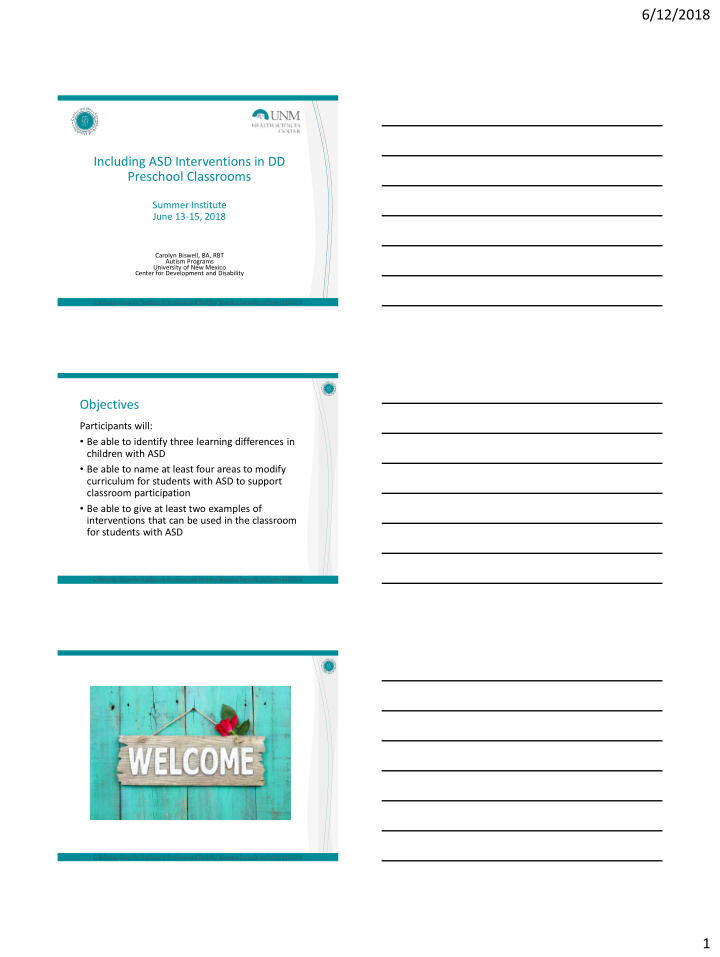



6/12/2018 Including ASD Interventions in DD Preschool Classrooms Summer Institute June 13-15, 2018 Carolyn Biswell, BA, RBT Autism Programs University of New Mexico Center for Development and Disability Objectives Participants will: • Be able to identify three learning differences in children with ASD • Be able to name at least four areas to modify curriculum for students with ASD to support classroom participation • Be able to give at least two examples of interventions that can be used in the classroom for students with ASD 1
6/12/2018 What are we here to learn? Why is it Can I do this? important? How do we support Why should we children with modify? ASD? How should we modify? Learning Differences Students with autism may have difficulty with: • Attending • Participating in group activities • Transitioning • Following directions • Interacting with other students • Grabbing other students ’ materials or toys • Following routines 2
6/12/2018 Learning Differences They may also: • Have limited or no verbal skills • Demonstrate rigidity in routine or inflexibility with schedule • Tend to become easily upset or overstimulated • Have difficulty learning from other students/ picking up cues from their environment “Inclusion is not simply about the social experience. One of the repeated findings of the inclusion research is that just “being there” isn’t sufficient. There are critical features that are necessary for any child’s early learning experiences. Their development must be nurtured. Their experiences must be developmentally appropriate and individually planned. The child must be supported so that he or she may take advantage of the full complement of learning experiences .” (Sandall & Schwartz, 2002, p. 184) Curriculum Modifications Environmental Activities Materials Invisible Support Child Preferences Adult Support Peer Support Special Equipment 3
6/12/2018 Environmental Changing the physical and social environment and adapting the schedule to support learning opportunities and active engagement Physical Activity areas/learning centers Boundaries Work spaces Social Seating Group Activities Transitions Time Schedules Balance activities Activity Areas Activity Areas 4
6/12/2018 Boundaries Boundaries Work Spaces 5
6/12/2018 Work Spaces Social Arranging the environment or schedule to facilitate social interactions and engagement with peers • Play script/routine • Visual supports • Seating • Group Activities • Transitions 6
6/12/2018 Time • Visual schedule • Balance schedule of activities • Teach routines in logical sequence • Smaller groups • Schedule activities when extra adults present Activities • Less Steps/one direction at a time • Less pieces • Visual supports • Finished product example • 1:1 instruction • Model (I do, we do, you do) • Clear beginning/clear ending • Present choices visually 7
6/12/2018 Materials • Label to independently access and use • Modify to promote participation • Stimulus prompting • Present choices in picture format • Visual supports/picture cards 8
6/12/2018 9
6/12/2018 Invisible Support A purposeful arrangement of naturally occurring events within one activity • Sequence turn-taking • Sequence activities • Rotate activities within learning center (quiet, movement, listen, motor) • Incorporate a learning target into activity (sort or match first before are activity) • Gradually incorporate novel items into play activity (Sandall & Schwartz, 2002, p. 46) Child Preferences • Integrate the child’s preferences, special interests into the activity • Start with a preferred activity or mastered task • Pair with favorite person Adult Support • Join the activity • Provide a model • Facilitate interaction between students • Intervene in a preservative activity • Follow the child’s lead • Proximity • Incorporate learning goals 10
6/12/2018 Peer Support • Pair with a peer to help teach and follow routines • Share materials • Peer models what to do • Students pass out/collect materials • Peers hold hands in line Special Equipment • Cube chairs • Chairs with armrests • Foot support • Stand to work • Support child’s grasp • Be creative! How do we get it all in? • Direct instruction (DTT) • Communication opportunities • Data collection 11
6/12/2018 IEP at-a-glance IEP Objectives taught in the context of activities: Social, Peer interaction, and Friendship Skills that can be Targeted 1. during instructional time and other times as well: What level / type of supports will this student need currently? In the Physical safety issues or health concerns for student? future? Behavior supports needed /Behavior support plan (including restraint): How the student communicates, and supports that are needed: 1. Data collection procedures / monitoring: Communication with School and Home: 1. Plan for Transitions and Unexpected Events: Strategies to support participation in planned activities: 1. 1. Let’s Practice Environmental Activities Materials Invisible Support Child Preferences Adult Support Peer Support Special Equipment Special Equipment Invisible Support Child Preference Environmental Adult Support Peer Support Activities Materials Doesn’t come to circle time Has difficulty staying in circle time Won’t sit for an activity Bothers others during activity Difficulty lining up when time to come in from recess Difficulty with transitions Has difficulty getting on/off bus Does not follow directions/respond to a transition cue Has to be constantly reminded to follow a routine Has difficulty using toys appropriately Low levels of engagement Has lower skills than other students Child is easily over stimulated Child has no verbal language OTHER? 12
6/12/2018 Let’s review • Learning differences in students with ASD • Curriculum modifications • Interventions/strategies you can implement Questions Resources 1. Kabot, S. & Reeve, C. (2010) Setting up classroom spaces that support students with autism spectrum disorders. Shawnee Mission, KS; AAPC Publishing 2. ABA Resources (free downloads) http://www.abaresources.com/ 3. Center for Development and Disability http://www.cdd.unm.edu/ Thank you for sharing your classrooms with us! Albuquerque, Aztec, Las Cruces, Rio Rancho & Roswell 13
6/12/2018 Activity Concern/Difficulty What are you currently doing? How can you support? (Adapted from Sandall & Schwartz, 2002, Appendix A, Planning Worksheet) References: • Sandall, S.R., & Schwartz, I.S. (2002) Building blocks for teaching preschoolers with special needs. Baltimore, MD; Paul H. Brookes Publishing Co. 14
6/12/2018 Carolyn Biswell, BA, RBT Senior Program Therapist UNM Center for Development and Disability 505-272-9349 CBiswell21@salud.unm.edu 15
Recommend
More recommend